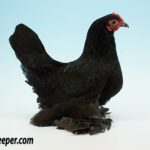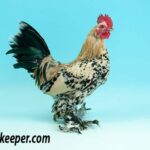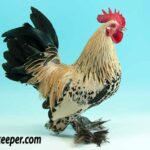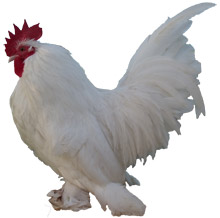
Uses: Exhibition.
Eggs: 150 – 180 tinted.
Origin: Germany, The Netherlands, Great Britain.
Weight: Cock: 850g, Hen: 750g.
Colours: Black, White, Blue, Lavender, Cuckoo, Black Mottled, Buff Mottled, Gold, Silver & Lemon Millefleur, Porcelain. Many more colours are found on the continent.
Useful to Know: A true bantam and a rare breed. Known as the Sabelpoot in the Netherlands where it is a very popular breed. In Germany they are called Federfüßige. Making a come back in the UK.
Photo: White Booted Bantam courtesy Alex Hales.
Bantams with feathered feet have been written about since the 1600s. The present day Booted Bantam was developed between Germany, The Netherlands and Great Britain. The blacks and whites have always been seen as British in origin- being smaller and more compact than the other colours.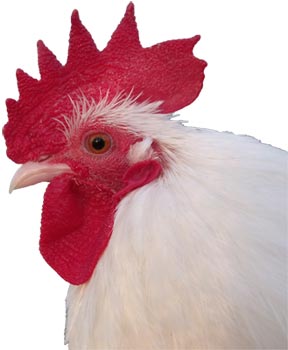
The Booted Bantam has a strong following from the backyard keeper in the UK, most notably in the Lemon Millefleur colouring. The breed is becoming more popular on the show bench with numbers increasing all the time.
The Booted Bantam should have a short and compact body with a prominent breast. Large, long wings should be carried at and almost resting on the vulture hocks. The tail should be full and held upright.
Photo Right: Head of a White Male Booted Bantam, photograph courtesy of Alex Hales
The breed is a reasonable layer of small, tinted eggs. Being small and easily tamed they are an ideal breed for small children although they are best kept in covered, mud-free runs or in pens indoors if kept for exhibition purposes to help keep their 6 inch long foot feathers in the best condition!
Photos
Books
The following books are available. Links take you to the Amazon or other sellers’ pages for the books.
- Rare Poultry Breeds – D. Scrivener – P.235
- Bantams – W.F Entwisle – P.47 (Reprint of the classic book of 1894)
- British Poultry Standards – P.75
- American Standard of Perfection – P.300
Breed Clubs
These are the breed clubs for Booted Bantams:


